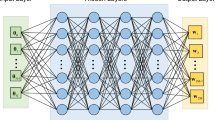Abstract
An adaptive beamforming method based on radial-basis function (RBF) neural network is examined for ultra-wideband (UWB) array illuminated by nearfield source in this paper. An analysis of the principle of space-time processing employing Gaussian monocycle model as UWB signal is conducted. The nearfield regionally constrain of UWB beamformer is reflected by a set of samples exerted on neural network training sample space. The recursive least square algorithm has been used for network weights updating. It improves the robustness against large errors in distance and directions of arrival. The efficiency and feasibility of presented approach is proved through the experimental results.
Preview
Unable to display preview. Download preview PDF.
Similar content being viewed by others
References
Fontana, R.J.: Recent System Applications of Short-Pulse Ultra-Wideband (UWB) Technology. IEEE Transactions on Microwave Theory and Techniques 52, 2087–2104 (2004)
Malek, G.M., Hussain: Principles of Space-Time Array Processing for Ultrawide-Band Impulse Radar and Radio Communications. IEEE Trans. on vehicular technology 51, 393–403 (2002)
Converse, M., Bond, E.J., Hagness, S.C.: Ultrawide-band Microwave Space-time Beamforming for Hyperthermia Treatment of Breast Cancer: A Computational Feasibility Study. IEEE Trans. on Microwave Theory and Techniques 52, 1876–1889 (2004)
Anderson, F., Christensen, W., Fullerton, L.: Ultra-wideband Beamforming in Sparse Arrays. In: Microwaves, Antennas and Propagation, IEE Proceedings, vol. 138, pp. 342–346 (1991)
Zheng, R.Y., Gourbran, R.A.: Robust Near-field Adaptive Beamforming with Distance Discrimination. IEEE Trans. on ASSP 12, 478–488 (2004)
Suksmono, A.B., Hirose, A.: Ultra-wideband Beamforming by Using a Complex-Valued Spatio-temporal Neural Network. In: Pal, N.R., Kasabov, N., Mudi, R.K., Pal, S., Parui, S.K. (eds.) ICONIP 2004. LNCS, vol. 3316, pp. 104–109. Springer, Heidelberg (2004)
Park, J., Sandberg, I.W.: Universal Approximation Using Radial-basis-function Networks. Neural Computation 3, 246–257 (1991)
Jiao, J.: Theory of Neural Networks System. Xidian University Press, Xi’an (1991)
Author information
Authors and Affiliations
Editor information
Editors and Affiliations
Rights and permissions
Copyright information
© 2005 Springer-Verlag Berlin Heidelberg
About this paper
Cite this paper
Wang, M., Yang, S., Wu, S. (2005). Ultra-wideband Nearfield Adaptive Beamforming Based on a RBF Neural Network. In: Wang, J., Liao, XF., Yi, Z. (eds) Advances in Neural Networks – ISNN 2005. ISNN 2005. Lecture Notes in Computer Science, vol 3497. Springer, Berlin, Heidelberg. https://doi.org/10.1007/11427445_92
Download citation
DOI: https://doi.org/10.1007/11427445_92
Publisher Name: Springer, Berlin, Heidelberg
Print ISBN: 978-3-540-25913-8
Online ISBN: 978-3-540-32067-8
eBook Packages: Computer ScienceComputer Science (R0)




